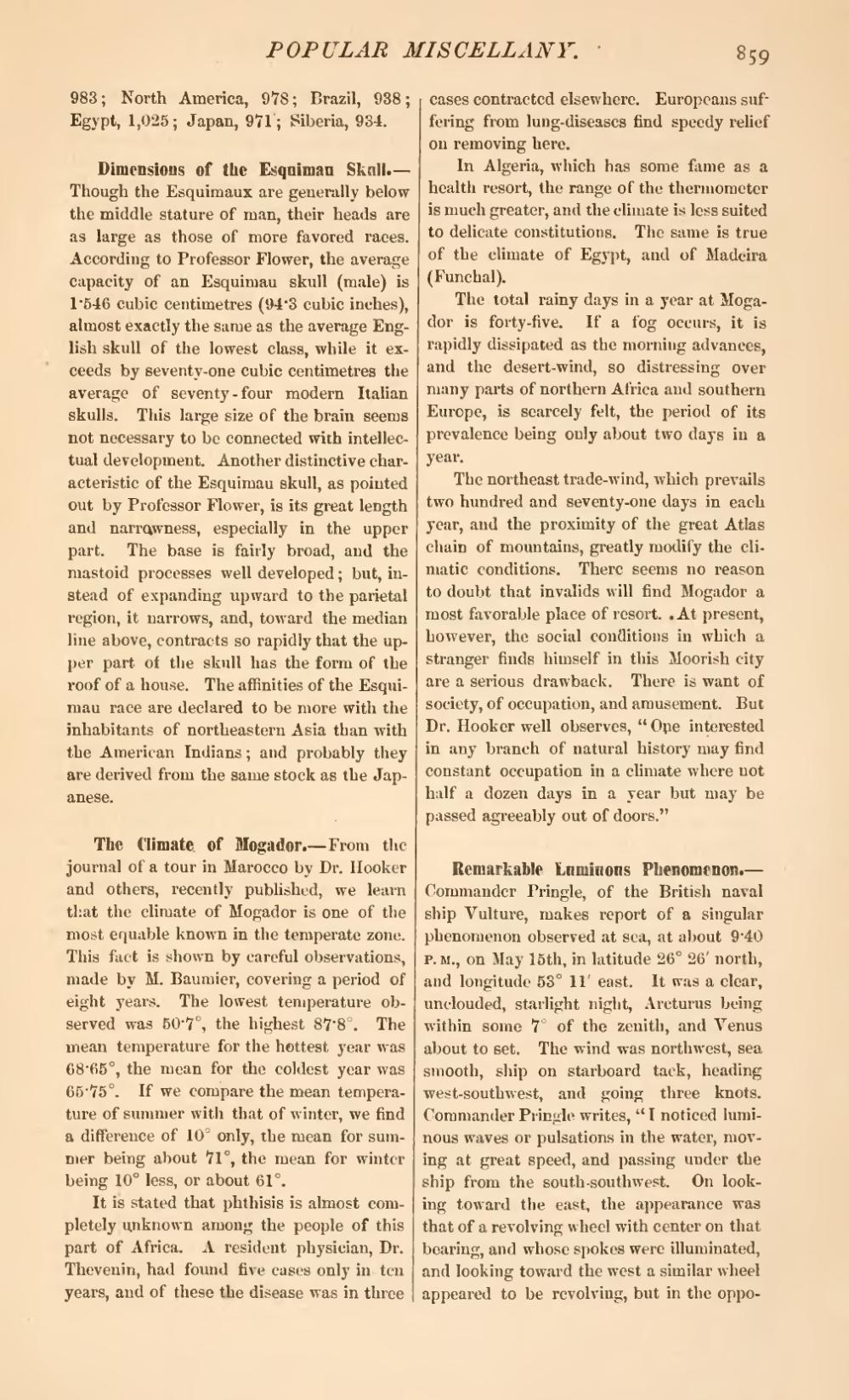983; North America, 978; Brazil, 938; Egypt, 1,025; Japan, 971; Siberia, 934.
Dimensions of the Esquimau Skull.—Though the Esquimaux are generally below the middle stature of man, their heads are as large as those of more favored races. According to Professor Flower, the average capacity of an Esquimau skull (male) is 1·546 cubic centimetres (94·3 cubic inches), almost exactly the same as the average English skull of the lowest class, while it exceeds by seventy-one cubic centimetres the average of seventy-four modern Italian skulls. This large size of the brain seems not necessary to be connected with intellectual development. Another distinctive characteristic of the Esquimau skull, as pointed out by Professor Flower, is its great length and narrowness, especially in the upper part. The base is fairly broad, and the mastoid processes well developed; but, instead of expanding upward to the parietal region, it narrows, and, toward the median line above, contracts so rapidly that the upper part of the skull has the form of the roof of a house. The affinities of the Esquimau race are declared to be more with the inhabitants of northeastern Asia than with the American Indians; and probably they are derived from the same stock as the Japanese.
The Climate of Mogador.—From the journal of a tour in Marocco by Dr. Hooker and others, recently published, we learn that the climate of Mogador is one of the most equable known in the temperate zone. This fact is shown by careful observations, made by M. Baumier, covering a period of eight years. The lowest temperature observed was 50·7°, the highest 87·8°. The mean temperature for the hottest year was 68·65°, the mean for the coldest year was 65·75°. If we compare the mean temperature of summer with that of winter, we find a difference of 10° only, the mean for summer being about 71°, the mean for winter being 10 less, or about 61°.
It is stated that phthisis is almost completely unknown among the people of this part of Africa. A resident physician, Dr. Thevenin, had found five cases only in ten years, and of these the disease was in three cases contracted elsewhere. Europeans suffering from lung-diseases find speedy relief on removing here.
In Algeria, which has some fame as a health resort, the range of the thermometer is much greater, and the climate is less suited to delicate constitutions. The same is true of the climate of Egypt, and of Madeira (Funchal).
The total rainy days in a year at Mogador is forty-five. If a fog occurs, it is rapidly dissipated as the morning advances, and the desert-wind, so distressing over many parts of northern Africa and southern Europe, is scarcely felt, the period of its prevalence being only about two days in a year.
The northeast trade-wind, which prevails two hundred and seventy-one days in each year, and the proximity of the great Atlas chain of mountains, greatly modify the climatic conditions. There seems no reason to doubt that invalids will find Mogador a most favorable place of resort. At present, however, the social conditions in which a stranger finds himself in this Moorish city are a serious drawback. There is want of society, of occupation, and amusement. But Dr. Hooker well observes, "One interested in any branch of natural history may find constant occupation in a climate where not half a dozen days in a year but may be passed agreeably out of doors."
Remarkable Luminous Phenomenon.—Commander Pringle, of the British naval ship Vulture, makes report of a singular phenomenon observed at sea, at about 9·40 p. m., on May 15th, in latitude 26° 26' north, and longitude 53° 11' east. It was a clear, unclouded, starlight night, Arcturus being within some 7° of the zenith, and Venus about to set. The wind was northwest, sea smooth, ship on starboard tack, heading west-southwest, and going three knots. Commander Pringle writes, "I noticed luminous waves or pulsations in the water, moving at great speed, and passing under the ship from the south-southwest. On looking toward the east, the appearance was that of a revolving wheel with center on that bearing, and whose spokes were illuminated, and looking toward the west a similar wheel appeared to be revolving, but in the oppo-
